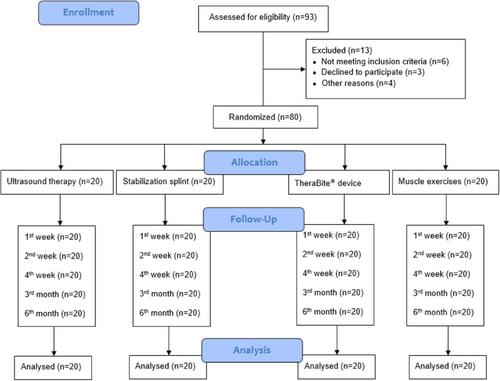Myofascial pain syndrome (MPS) is a particular type of temporomandibular joint disorder. Research findings comparing various treatment approaches are scarce and controversial. Therefore, this study aimed to compare the effectiveness of ultrasound therapy, stabilization splint, TheraBite device, and masticatory muscle exercises in reducing pain intensity and improving mandibular mobility in patients with MPS.
It was a single-blind, randomized, parallel-group, active-controlled trial that took place between April 2023 and October 2023 at the Department of Fixed Prosthodontics, Damascus University. Patients older than 18 years old with myofascial pain accompanied by limited jaw opening and pain lasting for at least 6 months were included. Eighty patients were randomly assigned into four groups using online randomization software: ultrasound therapy, stabilization splint, TheraBite device, and masticatory muscle exercises. Only outcome assessors were masked to treatment allocation. The exercise regimen was the exercise program for patients with TMD. The following primary outcome measures were considered at the baseline (t0), at the first (t1), second (t2), and fourth (t3) week of treatment, and at the second (t4) and fifth (t5) month of follow-up: pain intensity using the visual analogue scale, maximum interincisal opening, right lateral movement, and left lateral movement measured in millimeters.
The pain level changed from severe to mild at t3 in ultrasound therapy, stabilization splint, and TheraBite device groups. In the masticatory muscle exercises group, it changed to moderate, with a significant difference between ultrasound therapy (p = 0.012) and stabilization splint (p = 0.013) groups. In addition, the mandibular mobility continued to improve at the subsequent follow-up periods (t4 and t5).
All therapies are equally effective after 5-month follow-up. However, ultrasound therapy and stabilization splints have the benefit of achieving rapid improvement.
ISRCTN20833186.



